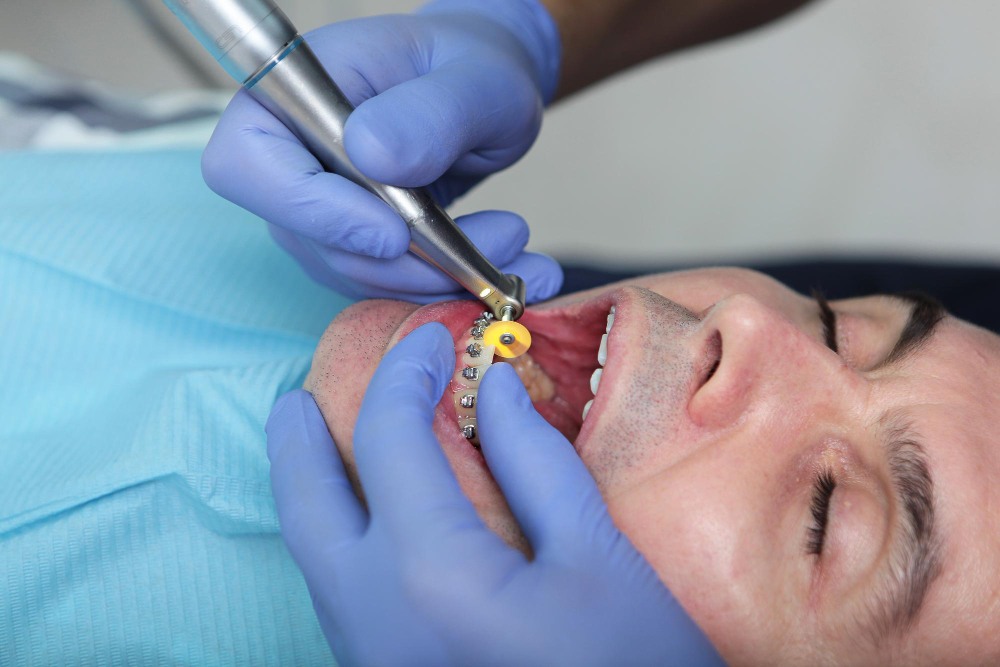Introduction
Dental fillings play a vital role in maintaining oral health by restoring teeth that have been damaged by decay, wear, or fractures. By filling in cavities or repairing cracks, fillings help preserve the natural tooth structure, prevent further damage, and maintain functionality. While there are several materials available for dental fillings, each with its own advantages, gold tooth fillings stand out due to their unique combination of durability, biocompatibility, and distinct appearance.
Understanding the Importance of Dental Fillings
Dental fillings not only restore the function and shape of damaged teeth but also help prevent further decay or infection. Without a filling, cavities or tooth damage can worsen over time, potentially leading to tooth loss or more invasive treatments like crowns or root canals. A well-placed filling provides protection and strengthens the tooth, allowing you to chew, speak, and smile with confidence.
What Makes a Gold Tooth Filling Different?
A gold tooth filling is made from a gold alloy, often mixed with other metals like copper for added strength. What sets a gold tooth filling apart from other materials is its superior durability. Gold fillings are highly resistant to wear and corrosion, allowing them to last for decades—sometimes even a lifetime with proper care. Unlike tooth-colored materials like composite or ceramic, gold tooth fillings are visibly distinct, making them both a functional and aesthetic choice for some patients.
Additionally, gold is biocompatible, meaning it’s well-tolerated by the body with minimal risk of allergic reactions or toxicity. This makes it an excellent option for patients looking for a safe and long-lasting dental restoration. In this guide, we’ll explore the pros and cons of gold teeth fillings, their longevity, and how to maintain them for optimal dental health.
How Long Do Gold Tooth Fillings Last?

Gold tooth fillings are renowned for their durability and longevity, often outlasting many other types of dental restorations. Understanding the lifespan of gold fillings and the factors that contribute to their durability can help you make an informed decision about whether they’re the right choice for you.
Average Lifespan of a Gold Tooth Filling
One of the standout features of a gold tooth filling is its remarkable longevity. On average, gold fillings can last between 15 and 30 years, with some lasting even longer when well-maintained. This far exceeds the lifespan of other common filling materials like composite, which typically lasts 5–10 years, or amalgam, which may last up to 15 years. In some cases, gold teeth fillings have been known to last a lifetime, making them a long-term, cost-effective option for dental restorations.
The extended lifespan of gold fillings is largely due to their resistance to wear and tear, corrosion, and fractures, which are common issues with other filling materials over time. If you’re seeking a solution that will stand the test of time, gold tooth fillings are an excellent investment.
Factors That Influence the Longevity of Gold Teeth Fillings
Several factors can influence how long a gold tooth filling will last. By understanding these factors, you can take proactive steps to maximize the lifespan of your filling:
- Oral Hygiene Practices: Proper dental care is key to ensuring that your gold filling lasts as long as possible. Regular brushing, flossing, and dental cleanings help prevent decay and gum disease, which can compromise the structure of the tooth around the filling.
- Chewing Habits: While gold fillings are highly durable, excessive grinding or clenching of the teeth (bruxism) can place additional strain on the filling and the surrounding tooth. If you have bruxism, using a night guard may help protect both your teeth and your filling.
- Location of the Filling: Fillings placed on molars or other back teeth, which experience more pressure from chewing, tend to wear out faster than those on front teeth. However, due to the strength of gold, this material is particularly well-suited for high-stress areas of the mouth.
- Dietary Habits: Avoiding extremely hard or sticky foods can help prolong the life of your gold tooth filling. These types of foods can place stress on the filling or even cause damage over time.
- Regular Dental Visits: Routine dental check-ups are crucial for maintaining the integrity of your gold filling. Your dentist can monitor its condition and ensure that it remains securely in place, addressing any potential issues before they become major problems.
Pros and Cons of Gold Tooth Fillings for Long-Term Use

How to Maintain Your Gold Tooth Filling
Maintaining your gold tooth filling is essential to ensure its longevity and functionality. While gold fillings are durable and resistant to wear, proper care is crucial to maximize their lifespan and maintain overall oral health. Here are some best practices for daily oral hygiene and the importance of regular dental check-ups.
Best Practices for Daily Oral Hygiene
- Brush Twice a Day: Use a fluoride toothpaste and a soft-bristled toothbrush to gently brush your teeth at least twice a day. Focus on all surfaces of your teeth, including the areas around your gold filling, to remove plaque and prevent decay.
- Floss Daily: Flossing is vital for cleaning the spaces between your teeth and around the filling. It helps remove food particles and plaque that your toothbrush might miss. Use gentle, sawing motions to avoid damaging the filling or the tooth structure.
- Use an Antimicrobial Mouthwash: Incorporating an antimicrobial mouthwash into your routine can help reduce plaque buildup and bacteria in your mouth, contributing to better overall oral health. Look for a mouthwash that is alcohol-free to prevent dryness.
- Avoid Hard and Sticky Foods: While gold fillings are strong, they can still be affected by extreme forces. Avoid chewing on hard foods like ice or hard candies, and steer clear of sticky foods that can dislodge or damage the filling.
- Stay Hydrated: Drinking plenty of water helps wash away food particles and maintain saliva flow, which is essential for neutralizing acids in the mouth. Saliva also helps protect your teeth and fillings from decay.
Regular Dental Check-ups and Professional Cleanings
Even with excellent daily care, it’s crucial to schedule regular dental check-ups and professional cleanings. Here’s why:
- Early Detection of Issues: During your dental visits, your dentist can closely examine your gold tooth filling and surrounding teeth for any signs of wear, damage, or decay. Early detection allows for timely intervention and can prevent more serious issues down the line.
- Professional Cleanings: Regular professional cleanings help remove tartar buildup that brushing and flossing alone may not eliminate. This not only helps keep your mouth healthy but also ensures that the area around your filling remains free from plaque and bacteria.
- Adjustments and Maintenance: Over time, your dentist can check the fit of your gold filling and make any necessary adjustments to ensure it remains secure and effective. This can also prevent future complications and extend the life of your filling.
- Tailored Advice: Your dentist can provide personalized recommendations based on your oral health, lifestyle, and specific needs. This guidance can help you maintain your gold tooth filling and achieve optimal dental health.
Avoiding Habits That Can Damage Gold Fillings
While gold tooth fillings are known for their exceptional durability, certain habits can jeopardize their integrity and lead to complications. Being mindful of your behaviors can help protect your fillings and prolong their lifespan. Here are some habits to avoid:
- Chewing on Hard Objects: Avoid chewing on hard items such as ice, hard candies, or non-food items like pens and pencils. These habits can place excessive pressure on gold fillings, potentially causing them to crack or become dislodged.
- Grinding or Clenching Teeth: Teeth grinding (bruxism) can put tremendous stress on dental fillings. If you have a habit of grinding or clenching your teeth—especially during sleep—consider discussing it with your dentist. They may recommend a custom night guard to protect your fillings and teeth.
- Eating Sticky Foods: Sticky candies, taffy, or caramel can adhere to your gold fillings and may dislodge them or loosen the bond with the tooth. If you enjoy these treats, be cautious and limit your intake to protect your fillings.
- Neglecting Oral Hygiene: Poor oral hygiene can lead to plaque buildup around your fillings, increasing the risk of decay or gum disease. Make it a habit to brush and floss regularly, as mentioned in the previous section, to keep your mouth healthy and protect your fillings.
- Skipping Regular Dental Visits: Failing to visit your dentist for regular check-ups and cleanings can lead to unnoticed issues that might compromise your gold fillings. Ensure you attend scheduled appointments to catch any potential problems early.
- Using Your Teeth as Tools: Using your teeth to open packages, bottles, or other objects can create unnecessary strain on your fillings and teeth. Always use proper tools for these tasks to avoid damaging your dental work.
- Excessive Alcohol or Caffeine Intake: High consumption of acidic beverages like soda or excessive coffee can erode tooth enamel and negatively impact your dental health. If you consume these drinks, rinse your mouth with water afterward to neutralize acids and protect your fillings.
Comparing Gold Fillings to Other Dental Materials

When it comes to dental restorations, various materials are available, each with its unique characteristics, advantages, and disadvantages. Understanding how gold tooth fillings compare to other options like composite, amalgam, and ceramic fillings is essential for making an informed decision about your dental health.
Gold vs. Composite: Which Lasts Longer?
Composite fillings are made from a resin material that is designed to blend seamlessly with the natural color of your teeth. While they offer excellent aesthetics, they generally have a shorter lifespan compared to gold fillings.
On average, composite fillings last between 5 to 10 years, depending on factors such as the location of the filling, oral hygiene practices, and the patient’s eating habits. In contrast, gold fillings can last 15 to 30 years or more with proper care. Their superior durability and resistance to wear make them ideal for areas of the mouth that experience heavy chewing forces, such as molars.
However, the choice between gold and composite fillings also depends on aesthetic preferences. While composite fillings provide a more natural appearance, gold fillings offer distinct durability and longevity. Ultimately, if long-term durability is your primary concern, gold fillings are the superior choice.
How Gold Teeth Fillings Compare to Amalgam and Ceramic Fillings
Gold vs. Amalgam Fillings
Amalgam fillings are made from a mixture of metals, including mercury, silver, and tin. They are known for their strength and are often used in posterior teeth where durability is crucial. Amalgam fillings can last around 10 to 15 years, making them less long-lasting than gold fillings but generally more affordable.
While both gold and amalgam fillings are durable, gold fillings have a more extended lifespan and a lower risk of corrosion. Additionally, gold is biocompatible, which means it poses minimal risk of allergic reactions. However, amalgam fillings are more visible and can create a more noticeable appearance in the mouth, particularly if placed in front teeth.
Gold vs. Ceramic Fillings
Ceramic fillings, typically made of porcelain, offer excellent aesthetics and can closely match the color of natural teeth. They are also resistant to staining, making them a popular choice for patients concerned about the appearance of their dental work. However, ceramic fillings tend to be less durable than gold fillings and can last around 5 to 15 years, depending on various factors.
Ceramic fillings are more prone to chipping or cracking, especially in areas with high chewing forces. While they are excellent for aesthetic purposes, they may not be the best option for patients seeking long-lasting durability. Gold fillings, on the other hand, excel in strength and longevity, making them a more suitable choice for those who prioritize a long-term solution.
When to Replace Your Gold Tooth Filling

Gold tooth fillings are known for their remarkable durability and longevity, but like any dental restoration, they can eventually require replacement. Being aware of the signs that indicate it’s time for a new filling is crucial for maintaining your oral health. Here’s what you need to know about recognizing when your gold filling may need to be replaced and the importance of consulting your dentist.
Signs That Your Gold Filling Needs Replacement
- Visible Wear or Damage: One of the most apparent signs that your gold filling may need replacement is visible wear or damage. If you notice any cracks, chips, or deterioration in the filling, it’s essential to seek dental advice. While gold is durable, it is not impervious to wear.
- Increased Sensitivity: If you experience heightened sensitivity to hot or cold temperatures in the tooth with the gold filling, it could indicate that the filling is compromised or that decay is forming underneath. This sensitivity may signal that it’s time for a replacement.
- Pain or Discomfort: Any persistent pain or discomfort in the tooth where the gold filling is located may be a cause for concern. This could indicate an issue with the filling itself, or it may suggest that there is decay or damage to the surrounding tooth structure.
- Gaps or Marginal Leakage: If you notice any gaps between the filling and the tooth, or if food particles seem to get trapped in that area, it may indicate that the seal of the filling has been compromised. This can lead to decay beneath the filling, necessitating replacement.
- Changes in Bite: If you experience discomfort or an uneven bite after getting a gold filling, it may need to be adjusted or replaced. A properly fitting filling should not cause any changes in your bite or discomfort when chewing.
Consulting Your Dentist: When Is It Time for a New Filling?
It’s essential to consult your dentist if you notice any of the signs mentioned above or if you have concerns about your gold filling. Your dentist will conduct a thorough examination, using visual checks and X-rays to assess the condition of the filling and the surrounding tooth structure.
During your appointment, your dentist can determine whether your gold filling can be repaired or if it needs to be replaced entirely. If replacement is necessary, they can discuss your options, helping you understand the pros and cons of gold teeth fillings compared to other materials.
Regular dental check-ups are also crucial for monitoring the condition of your fillings and overall oral health. Your dentist can spot potential issues before they become significant problems, allowing for timely intervention and ensuring the longevity of your dental work.
Conclusion

In this detailed guide, we’ve explored the longevity and benefits of gold tooth fillings, highlighting why they remain a popular choice for dental restorations. Their remarkable durability, often lasting 15 to 30 years or even longer with proper care, sets gold fillings apart from other materials such as composite or amalgam. Not only do they offer exceptional strength and resistance to wear, but their biocompatibility also makes them a safe choice for most patients.
Recap: The Longevity and Benefits of Gold Tooth Fillings
Gold fillings are renowned for their longevity and reliability, making them an ideal option for individuals seeking a long-term solution to dental issues. They are particularly well-suited for areas in the mouth that experience significant chewing forces, such as molars. Additionally, gold fillings require minimal maintenance when cared for properly through good oral hygiene practices and regular dental visits.
Furthermore, the aesthetic appeal of gold fillings, while not as discreet as composite or ceramic alternatives, has its own charm and appeal for some patients. For those who prioritize durability and long-term performance, gold fillings provide a compelling solution that can withstand the test of time.
Final Considerations for Choosing Gold Teeth Fillings
When considering whether to opt for a gold tooth filling, it’s essential to weigh the pros and cons of gold teeth fillings. While they tend to be more expensive than other materials, their longevity can make them a cost-effective investment in the long run. Additionally, consulting with your dentist can help you understand the best options based on your unique dental needs, preferences, and lifestyle.
Ultimately, choosing a gold filling involves a combination of factors, including aesthetic considerations, cost, and personal comfort with the material. By making an informed decision, you can enjoy the long-lasting benefits of gold fillings while maintaining your oral health for years to come. Remember, keeping an open line of communication with your dentist will further ensure you receive the best possible care tailored to your specific situation.


